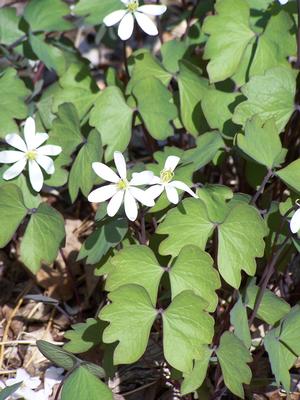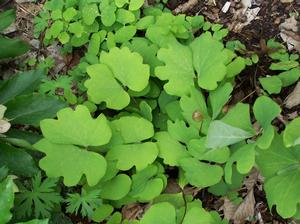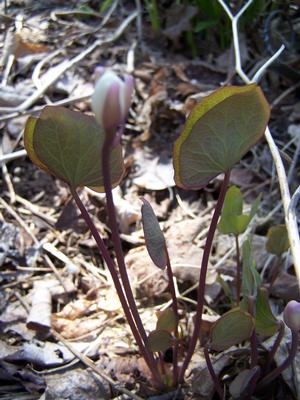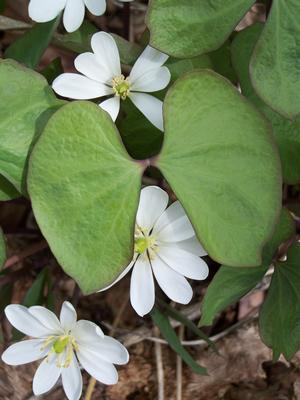
Jeffersonia diphylla 'Monkey Wings' in April

'Monkey Wings' again... look closely for the single curious seed pod - this picture taken in mid summer

Typical leaf form evident in the newly emergent leaves just beginning to unclasp from the closed position.

Typical smooth-edged paired leaves with peak flowers
Jeffersonia diphylla - Twinleaf
Jeffersonia diphylla or Twinleaf is a refined perennial from Eastern North America. Often thought to be an Appalachian plant Jeffersonia's nativity is broader. Found in Ontario, New York to Georgia and Alabama Jeffersonia relishes damp, rich open shade to dapple-lit woodlands right into Iowa and Minnesota. It is a very well-behaved clumping perennial but if content will provide you with self-sown young plants nearby a flowering adult. Though not found in our native deciduous woodlands Twinleaf is hardy for us in USDA zone 5 to 7. Never a nuisance self-sown plants arising among other denizens add a naturalistic flair in the shady garden. The more unplanned mixing of species in this realm the closer the resemblance to the woodland conditions in which this marvelous perennial is found.
The ephemeral flower in April-May is a one-inch cupped daisy in white to the palest pastel pink. The petals connect at a small yellow central spot, the sexual parts, at the top of each wiry stem rising from about 9 to 14 inches. Each daisy is comprised of four sepals which quickly desiccate and drop though the eight narrow petals hold for their brief but welcome moment in the spring calendar. One flower per stem is the rule. One pair of kidney-shaped leaves per stem follow and overlap with the flowers eventually stretching to near the same height or a bit shorter. The flowers pass quickly but the foliage which is quite handsome lasts much of the growing season. Interestingly, the leaf stems can continue to stretch after flowering and on some specimens may achieve up to 18 inches in height.
The paired leaves often emerge with a bronze to purple flush. Foliage matures to medium-light green. Jeffersonia adds a distinctive air and feel creating pleasing soft appeal with ferns or Fringed Bleeding Heart (Dicentra formosa) but can contribute to aesthetic tension and strength when paired with bolder-leaved plants such as Astilboides tabularis, Jack-in-the-pulpits, woodland peony (Paeonia japonica) or Japanese Wood Poppy (Glaucidium palmatum).
Little green seed pods looking like little pears eventually dry and turn brown. When the drying process applies enough pressure they pop open and the seed flies forth in a quiet explosion generally only seen by the woodland faeries. The seed pods remain after seed expulsion now resembling itsy bitsy hard-textured Jack-in-the-pulpits. These can be harvested for tiny dried arrangements where they add an interesting, fascinating presence in miniature.
A member of the Berberidaceae or Barberry family, Jeffersonia was name for Thomas Jefferson by friend and botanist William Bartram. The species, diphylla, of course refers to the paired leaves one mirroring the other. The genus contains only one other member, the Japanese counterpart known as Jeffersonia dubia. The paired leaves of Jeffersonia dubia are more rounded and the daisy-like flowers are tinged blue. There are reported hybrids between the two species though we have never actually seen them. If they exist they are as rare as a three dollar bill.
Amerindians steeped the root of Twinleaf into a tea to ease cramps, spasms, nervous excitability, diarrhea. It was used as a diuretic for kidney stones and urinary infections, and even as a gargle for sore throats. Externally as a wash it fought rheumatism, sores, ulcers, inflammation, and cancerous sores. Please note: as with digitalis (foxglove) which also harbors medicinal properties in the smallest doses Twinleaf is probably toxic. Never ever use wild plants medicinally most especially if to be ingested unless you are trained and qualified in herbal lore or know someone who is. And if you should take their advice and remedy be certain that they like you a whole lot! As back up it may be wise to check with your primary care physician, too.
MONKEY WINGS
There is but one named selection of Twinleaf. Jeffersonia diphylla 'Monkey Wings' was spotted by Leslie Shields, president of the Connecticut Hardy Plant Society. She tapped me on the shoulder, pointed and informed me in no uncertain terms that I needed to name and introduce this Twinleaf with a difference. Yes, the only name selection was spotted and henceforth named at Quackin' Grass Nursery and at the urging of Leslie is our introduction. This selection of Twinleaf exhibits the beautiful distinct paired leaves but with a difference: instead of the usual straight-edged kidneys the leaves display gentle lobes. The clasped leaves emerge in early spring already demonstrating the lobes at the outer leaf margins. They arise with a flush of bronze-purple. The leaves gently open like a pair of wings and expand into their adult form like a pupating insect. We named this selection ‘Monkey Wings’ for the flying monkeys in the Wizard of Oz as a departure from the plethora of too-cute garden plant monikers which flood the senses and overload the synapses with adorable saccharine sweet. (Was that harsh?) Some seedlings come relatively true but only a division will provide one with the actual and original 'Monkey Wings'.
As a general warning to unsuspecting gardeners it is a fact that oftentimes seed-grown strains of named cultivars gradually through successive generations become watered down; their distinct traits and the reason for a cultivar name diminish and can be entirely lost in time. Cloning is the most assured way to acquire a truly named plant.
Jeffersonia diphylla is a very worthy woodlander that will charm you in cool shade on the hottest summer days. Might you not consider one or more for planting in your quiet realm. Dig in and have fun.
penned by Wayne Paquette, September 2014